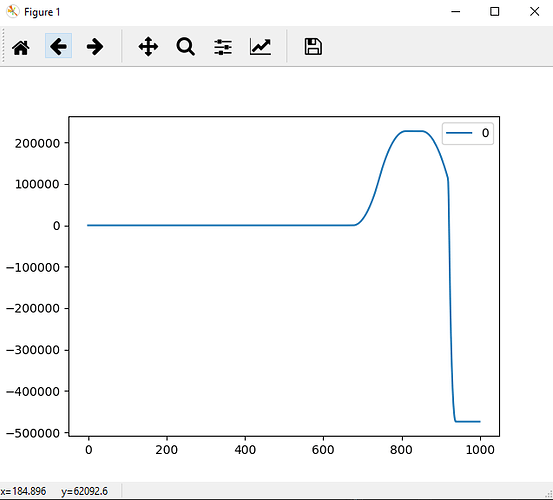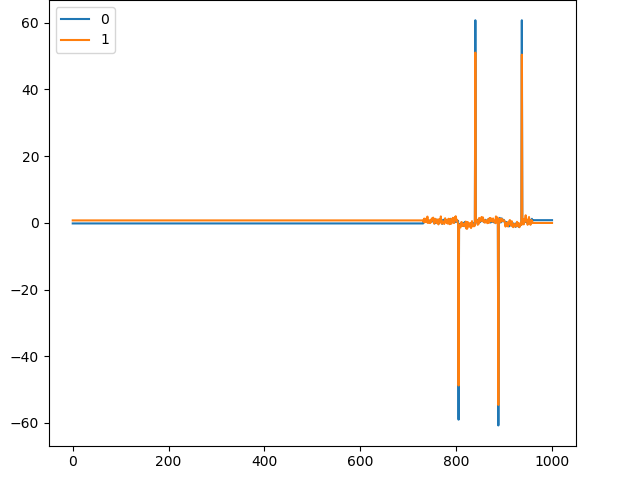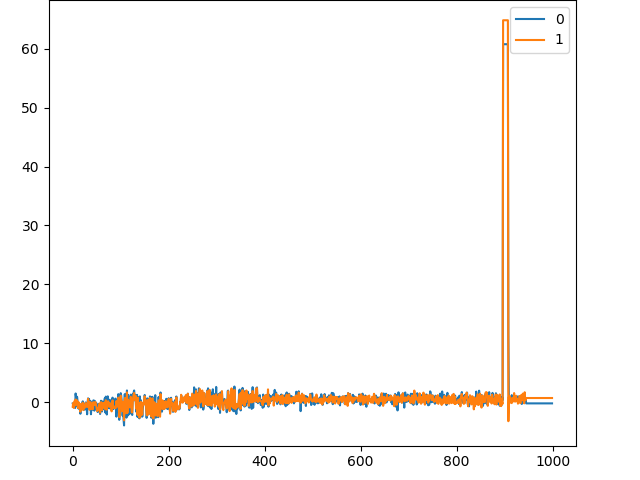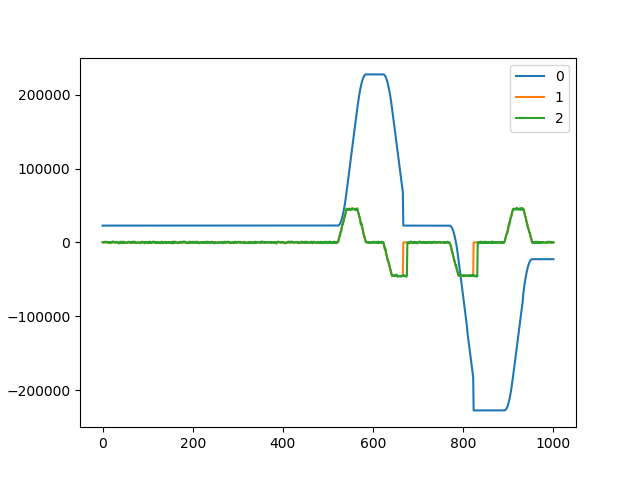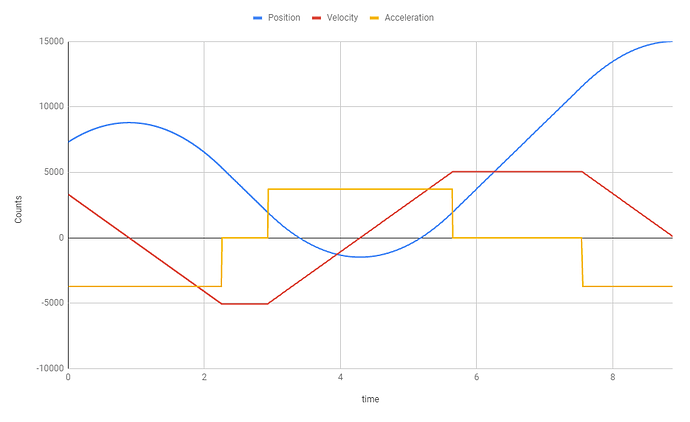Hi,
I finally found some time to get the parameters. Too much to do! 
Below is a copy of the .json file, I am using Axis0. With this setup I am able to replicate the happenings. I will be available for more testing if there is anything you would like me to test or do, things have calmed down a bit now.
{
"config": {
"brake_resistance": 2.0,
"max_regen_current": 0.0,
"enable_uart": true,
"enable_i2c_instead_of_can": false,
"enable_ascii_protocol_on_usb": true,
"dc_bus_undervoltage_trip_level": 8.0,
"dc_bus_overvoltage_trip_level": 59.92000198364258,
"power_supply_wattage": 0.0
},
"axis0": {
"config": {
"startup_motor_calibration": false,
"startup_encoder_index_search": true,
"startup_encoder_offset_calibration": false,
"startup_closed_loop_control": false,
"startup_sensorless_control": false,
"startup_homing": false,
"enable_step_dir": false,
"counts_per_step": 2.0,
"watchdog_timeout": 0.0,
"step_gpio_pin": 1,
"dir_gpio_pin": 2,
"can_node_id": 113,
"can_heartbeat_rate_ms": 0
},
"motor": {
"config": {
"pre_calibrated": true,
"pole_pairs": 7,
"calibration_current": 10.0,
"resistance_calib_max_voltage": 2.0,
"phase_inductance": 2.872193363145925e-05,
"phase_resistance": 0.04717841371893883,
"direction": -1,
"motor_type": 0,
"current_lim": 60.0,
"current_lim_tolerance": 1.25,
"inverter_temp_limit_lower": 100.0,
"inverter_temp_limit_upper": 120.0,
"requested_current_range": 60.0,
"current_control_bandwidth": 1000.0
}
},
"controller": {
"config": {
"control_mode": 3,
"input_mode": 1,
"pos_gain": 25.0,
"vel_gain": 0.00019999999494757503,
"vel_integrator_gain": 0.0024999999441206455,
"vel_limit": 327680.0,
"vel_limit_tolerance": 3.0,
"vel_ramp_rate": 1.0,
"homing_speed": 8192.0,
"inertia": 0.0,
"input_filter_bandwidth": 2.0
}
},
"encoder": {
"config": {
"mode": 0,
"use_index": true,
"find_idx_on_lockin_only": false,
"pre_calibrated": true,
"abs_spi_cs_gpio_pin": 0,
"zero_count_on_find_idx": true,
"cpr": 8192,
"offset": -4827,
"offset_float": 0.2564374804496765,
"enable_phase_interpolation": true,
"bandwidth": 1000.0,
"calib_range": 0.019999999552965164,
"calib_scan_distance": 50.26548385620117,
"calib_scan_omega": 12.566370964050293,
"idx_search_unidirectional": false,
"ignore_illegal_hall_state": false
}
},
"sensorless_estimator": {
"config": {
"observer_gain": 1000.0,
"pll_bandwidth": 1000.0,
"pm_flux_linkage": 0.0015800000401213765
}
},
"trap_traj": {
"config": {
"vel_limit": 327680.0,
"accel_limit": 1137777.75,
"decel_limit": 1137777.75
}
},
"min_endstop": {
"config": {
"gpio_num": 5,
"enabled": true,
"offset": -8192,
"is_active_high": false,
"debounce_ms": 100.0
}
},
"max_endstop": {
"config": {
"gpio_num": 6,
"enabled": true,
"offset": 0,
"is_active_high": false,
"debounce_ms": 100.0
}
}
},
"axis1": {
"config": {
"startup_motor_calibration": false,
"startup_encoder_index_search": false,
"startup_encoder_offset_calibration": false,
"startup_closed_loop_control": false,
"startup_sensorless_control": false,
"startup_homing": false,
"enable_step_dir": false,
"counts_per_step": 2.0,
"watchdog_timeout": 0.0,
"step_gpio_pin": 7,
"dir_gpio_pin": 8,
"can_node_id": 0,
"can_heartbeat_rate_ms": 0
},
"motor": {
"config": {
"pre_calibrated": false,
"pole_pairs": 7,
"calibration_current": 10.0,
"resistance_calib_max_voltage": 2.0,
"phase_inductance": 0.0,
"phase_resistance": 0.0,
"direction": 0,
"motor_type": 0,
"current_lim": 10.0,
"current_lim_tolerance": 1.25,
"inverter_temp_limit_lower": 100.0,
"inverter_temp_limit_upper": 120.0,
"requested_current_range": 60.0,
"current_control_bandwidth": 1000.0
}
},
"controller": {
"config": {
"control_mode": 3,
"input_mode": 1,
"pos_gain": 20.0,
"vel_gain": 0.0005000000237487257,
"vel_integrator_gain": 0.0010000000474974513,
"vel_limit": 20000.0,
"vel_limit_tolerance": 1.2000000476837158,
"vel_ramp_rate": 10000.0,
"homing_speed": 2000.0,
"inertia": 0.0,
"input_filter_bandwidth": 2.0
}
},
"encoder": {
"config": {
"mode": 0,
"use_index": false,
"find_idx_on_lockin_only": false,
"pre_calibrated": false,
"abs_spi_cs_gpio_pin": 0,
"zero_count_on_find_idx": true,
"cpr": 8192,
"offset": 0,
"offset_float": 0.0,
"enable_phase_interpolation": true,
"bandwidth": 1000.0,
"calib_range": 0.019999999552965164,
"calib_scan_distance": 50.26548385620117,
"calib_scan_omega": 12.566370964050293,
"idx_search_unidirectional": false,
"ignore_illegal_hall_state": false
}
},
"sensorless_estimator": {
"config": {
"observer_gain": 1000.0,
"pll_bandwidth": 1000.0,
"pm_flux_linkage": 0.0015800000401213765
}
},
"trap_traj": {
"config": {
"vel_limit": 20000.0,
"accel_limit": 5000.0,
"decel_limit": 5000.0
}
},
"min_endstop": {
"config": {
"gpio_num": 0,
"enabled": false,
"offset": 0,
"is_active_high": false,
"debounce_ms": 100.0
}
},
"max_endstop": {
"config": {
"gpio_num": 0,
"enabled": false,
"offset": 0,
"is_active_high": false,
"debounce_ms": 100.0
}
}
},
"can": {
"config": {
"baud_rate": 500000
}
}
}
